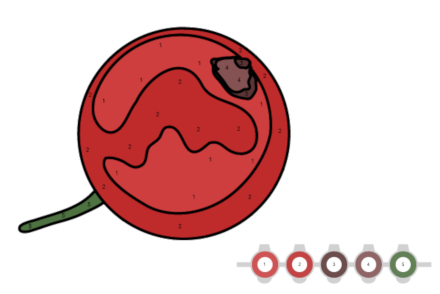Paint-by-number kits assign colors to specific areas to reproduce art, including great works like Leonardo da Vinci’s The Last Supper — one of the most popular paint-by-number kits ever sold. Da Vinci, artist, mathematician, architect, engineer, and more, used numbers to see the world — perhaps best exemplified by his Vitruvian Man, which describes the proportions and associated geometries of the human form. Dan Robbins, the creator of paint-by-number kits, apparently copied the paint-by-number concept from da Vinci. Recounting his inspiration, Robbins heard how da Vinci would give apprentices numbered patterns indicating where certain colors should be used in specific projects.
Payers and hospitals also use numbers to see the world. Access decisions are strategic, even artful, and driven by numbers. In a sense, when making market access decisions, payers and hospitals always paint by number.
The numbers
Efficacy, safety, and cost — key drivers of access decisions — are all expressed by numbers. Efficacy endpoints vary across therapeutic areas and products, but all have one thing in common: numbers. Take cancer drug clinical trials. Whether it is overall survival, endpoints based on tumor assessments, endpoints involving symptom assessments, or biomarkers, numbers are used to describe efficacy.
Similarly, numbers are used to describe safety endpoints. For example, the National Care Institute developed a grading system to define the severity of adverse events: “1” is mild or no symptoms (no intervention required); “2” is moderate (minimal intervention indicated, some limitation of activities); “3” is severe but not life threatening (hospitalization required, limitations on a patient’s ability to care for him/herself); “4” is life-threating (urgent intervention required); “5” is death related to an adverse event.
Payers and hospitals compare the relative performance of products by looking at the numbers. Some differences may be statistically significant, and some may be deemed clinically significant. While the latter requires somewhat subjective judgments, it’s the numbers that are judged.
Costs, of course, are numbers too. Numbers are used to calculate acquisition costs, including rebates and discounts, and to estimate cost offsets. The valuation of contract offers typically take market share, administrative costs, and opportunity costs into consideration — calculations all based on numbers. And the likelihood of a brand growing share? Yep, more numbers. Incidence, prevalence, utilization, satisfaction, adherence, persistence are still more numbers that payers and hospitals use to make access decisions. And both the predicted and actual number of exceptions and appeals — including the denials upheld and overturned — may also impact payers’ access decisions.
The paintings
Using broad brushstrokes, payers and hospitals follow the numbers and, as a result, their access portraits often look similar. Yet the products that these organizations advantage or disadvantage — or even exclude — and how they go about advantaging and disadvantaging products can vary. Is this evidence that payers and hospitals don’t follow numbers? No — and let’s count the ways numbers can yield variable access decisions.
First, the efficacy and safety numbers that payers and hospitals use to make access decisions may not be the same. Rather than limit their palettes to manufacturer-supplied data, they can mix in their own numbers. Real-world evidence — especially their own — can be much more relevant than evidence based on controlled clinical trials. Patient populations and care delivery systems vary along with outcomes. Numbers are local.
Second, the cost numbers that payers and hospitals use to make access decisions may not be the same. Manufacturers may make different offers to different payers and hospitals. Often, the best deals are offered to the largest payers and hospitals, which generally have the most bargaining power when negotiating rebates, discounts, and other contract terms. Numbers are scalable.
Third, even when the numbers are the same, access decisions may differ. Payers and hospitals have different patients, providers, and clients, not to mention different competitors, resources, and constraints. Importantly, they have different approaches to creating and sustaining a competitive advantage. An organization focused on lower costs will make different access decisions than an organization using the same data but differentiating itself with unique and valued offerings. Payers and hospitals have different leaders, philosophies, histories, and cultures. For example, some believe that the highest quality will yield the lowest costs. Numbers are strategic.
Paint by number
Despite the popular success of paint-by-number kits during the 1950s, critics frowned on the process. Paint-by-numbers is now synonymous with formulaic and showing no original thought or creativity. Though patterns in formularies and medical policies emerge, the variability among organizations and across therapeutic areas illustrates how these access decisions are driven by numbers but are not formulaic. While some payers and hospitals may follow access decisions made by competitors, some will use numbers to be creative and lead the way.
New products, offers, and evidence emerge — numbers change over time. Rather than painting themselves into a corner, payers and hospitals routinely follow the numbers and modify formularies and medical policies when a new color or fresh coat is deemed to be advantageous. Imaging technology of paintings show how the masters similarly revised their work and sometimes started over.
The formularies and medical policies that payers and hospitals create are always colorful and sometimes controversial. The hue and cry over some access decisions does not necessarily mean the decisions were not rational or numbers-driven. Some stakeholders may not like the numbers payers and hospitals use (or don’t use) and how they interpret or act upon those numbers — but they do paint by number — and that’s a good thing.
For sure, access decision making is as much art as it is science. Those who understand and appreciate this are better prepared to help manufacturers create and communicate numbers that can shape market access. And studying how payers and hospitals paint by number is in and of itself a source of happiness. As Leonardo da Vinci said, “The noblest pleasure is the joy of understanding.”



No Comments